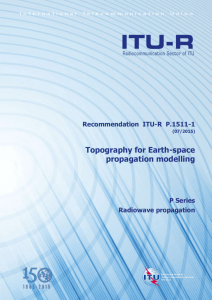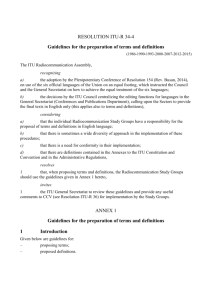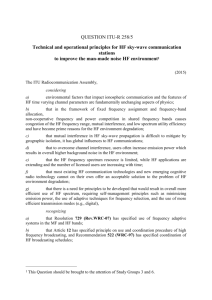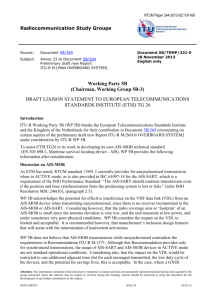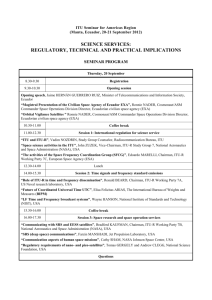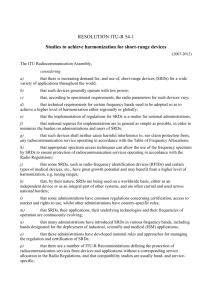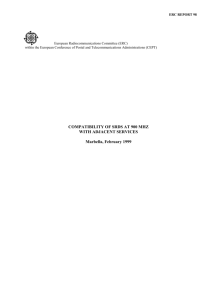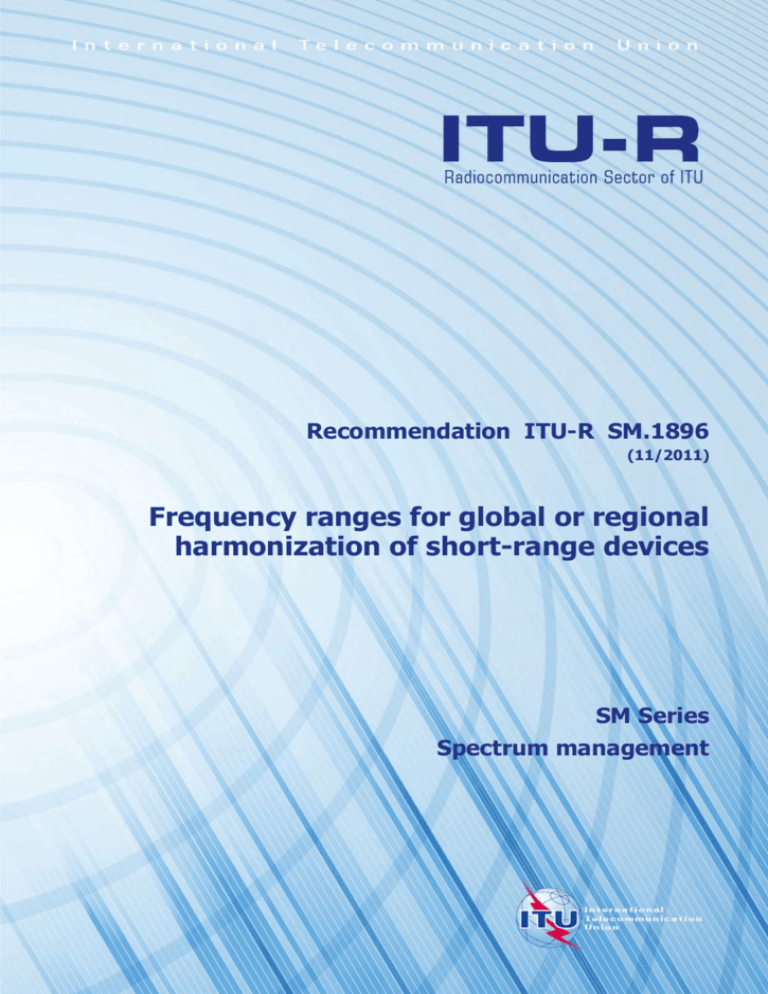
Recommendation ITU-R SM.1896
(11/2011)
Frequency ranges for global or regional
harmonization of short-range devices
SM Series
Spectrum management
ii
Rec. ITU-R SM.1896
Foreword
The role of the Radiocommunication Sector is to ensure the rational, equitable, efficient and economical use of the
radio-frequency spectrum by all radiocommunication services, including satellite services, and carry out studies without
limit of frequency range on the basis of which Recommendations are adopted.
The regulatory and policy functions of the Radiocommunication Sector are performed by World and Regional
Radiocommunication Conferences and Radiocommunication Assemblies supported by Study Groups.
Policy on Intellectual Property Right (IPR)
ITU-R policy on IPR is described in the Common Patent Policy for ITU-T/ITU-R/ISO/IEC referenced in Annex 1 of
Resolution ITU-R 1. Forms to be used for the submission of patent statements and licensing declarations by patent
holders are available from http://www.itu.int/ITU-R/go/patents/en where the Guidelines for Implementation of the
Common Patent Policy for ITU-T/ITU-R/ISO/IEC and the ITU-R patent information database can also be found.
Series of ITU-R Recommendations
(Also available online at http://www.itu.int/publ/R-REC/en)
Series
BO
BR
BS
BT
F
M
P
RA
RS
S
SA
SF
SM
SNG
TF
V
Title
Satellite delivery
Recording for production, archival and play-out; film for television
Broadcasting service (sound)
Broadcasting service (television)
Fixed service
Mobile, radiodetermination, amateur and related satellite services
Radiowave propagation
Radio astronomy
Remote sensing systems
Fixed-satellite service
Space applications and meteorology
Frequency sharing and coordination between fixed-satellite and fixed service systems
Spectrum management
Satellite news gathering
Time signals and frequency standards emissions
Vocabulary and related subjects
Note: This ITU-R Recommendation was approved in English under the procedure detailed in Resolution ITU-R 1.
Electronic Publication
Geneva, 2011
ITU 2011
All rights reserved. No part of this publication may be reproduced, by any means whatsoever, without written permission of ITU.
Rec. ITU-R SM.1896
1
RECOMMENDATION ITU-R SM.1896
Frequency ranges for global or regional harmonization
of short-range devices
(2011)
Scope
This Recommendation contains frequency ranges to be used as recommended ranges for short-range devices
(SRDs) applications requiring operation on a global or regional harmonized basis.
The ITU Radiocommunication Assembly,
considering
a)
that the 2007 Radiocommunication Assembly approved Resolution ITU-R 54 – Studies to
achieve harmonization for short-range radiocommunication devices (SRDs);
b)
that there is an increasing demand for and use of SRDs for a wide variety of applications
throughout the world;
c)
that SRD applications are deployed in both bands designated for ISM (industrial, scientific
and medical) applications and bands not designated for ISM applications;
d)
that SRDs are not ISM applications as defined in No. 1.15 of the Radio Regulations (RR);
e)
that, by their nature, SRDs are being used on a worldwide basis, either as an independent
device or as an integral part of other systems, and are often carried and used across national borders;
f)
that, in some frequency bands, specific interference mitigation techniques may facilitate the
operation of SRDs;
g)
that some SRDs may employ advanced spectrum access techniques;
h)
that using SRDs with similar technical characteristics, such as interference potential and
mitigation techniques, in suitable spectrum with appropriate emission limits could enhance the
coexistence of SRDs;
j)
that SRD applications are increasing, which may result in increasing spectrum demands
(some examples are UWB, RFID, etc.);
k)
that it may be necessary to use the existing spectrum more efficiently and economically,
further considering
a)
that SRDs may create the potential for harmful interference to radiocommunication
services, and some of them can be carried by individuals across national boundaries and,
noting
a)
that Resolution ITU-R 54 states that the ITU-R should continue its studies to enable
implementation of advanced technologies for SRDs, thereby in particular focusing on a strategy for
the future;
b)
that frequency ranges, power levels and other technical and operating parameters
commonly used by SRDs are listed in Report ITU-R SM.2153 – Technical and operating
parameters and spectrum use for short-range radiocommunication devices,
2
Rec. ITU-R SM.1896
recognizing
a)
that the regulatory framework for SRDs, such as the decision on frequency bands for use by
SRDs, is a national matter;
b)
that there are a number of benefits of global or regional harmonization of frequency ranges
for SRD usage for end users, manufacturers and regulators, such as:
−
a broader manufacturing base and increased volume of devices, resulting in economies of
scale and equipment availability;
−
improved spectrum utilization;
c)
that, in principle, SRDs have no requirement for an individual licence as they generally use
the radio spectrum on a non-interference and non-protected basis. However, in specific cases
licensing or registration may be required,
recommends
1
that for SRDs requiring operation on a global or regional harmonized basis, the frequency
ranges as specified in Annex 1 and Annex 2 may be considered, if appropriate.
Introduction to Annexes 1 and 2
Many SRD applications and the frequency bands in which they are deployed are described in
Report ITU-R SM.2153 – Technical and operating parameters and spectrum use for short-range
radiocommunication devices. Table 1 of this Recommendation lists common frequency bands that
are used for the deployment of SRDs in all regions of the world. However, not all of these bands
listed as common bands are harmonized for SRD use either globally or regionally.
Annex 1 of this Recommendation indicates frequency ranges that may be globally harmonized
under certain technical conditions and Annex 2 of this Recommendation indicates frequency ranges
that may be regionally harmonized under certain technical conditions.
Further studies may need to be undertaken in ITU-R to determine whether global or regional
harmonization of these ranges, or portions thereof, is feasible, given that there are many SRD
applications, such as those operating across national borders, that would benefit from worldwide
harmonization.
Example applications of such SRDs are the following: medical applications; SRD applications used
inside and outside aircraft; SRDs for supporting ID cards; some Intelligent Transport System (ITS)
applications; RFID applications for luggage handling systems in airports, item management,
logistics, livestock, electronic article surveillance (EAS) and near field communication (NFC). ISO
and other international standardization bodies have developed standards for many of these
applications.
Where SRDs operate in bands that are not harmonized either on a global or a regional basis, risks to
radiocommunication services increase. Moreover, differences in spectrum access conditions and
technical rules increase the costs to consumers of SRDs. Common frequency bands and technical
rules, such as recommended power levels and mitigation techniques, should be developed in ITU-R
Recommendations and Reports as guidance for national administrations.
Advanced spectrum access and mitigation techniques are being developed and these techniques may
allow SRDs to operate automatically within the tuning ranges that encompass frequency bands that
cannot be fully harmonized throughout the Regions. For low-cost SRDs, such as RFID tags, these
techniques may impose significant cost constraints and/or power limitations such as battery
lifetime. Therefore, these techniques may not be applicable to every SRD application.
Rec. ITU-R SM.1896
3
Annex 1
Frequency ranges for global harmonization of SRDs*
Frequency ranges as contained in Table below are based on information from Report ITU-R
SM.2153 and contributions from administrations attending relevant ITU-R meetings. The Table
may not reflect the actual situation. In this regard, further information is to be sought from
administrations.
Frequency range
Relevant Recommendation
9-148.5 kHz
3 155-3 400 kHz
Inductive SRD applications
ITU-R M.1076
Inductive SRD applications
RR No. 5.116
6 765-6 795 kHz
Inductive SRD applications
ISM band (RR No. 5.138)
Centre frequency 6 780 kHz
13.553-13.567 MHz
Inductive SRD applications
ISM band (RR No. 5.150)
Centre frequency 13.560 MHz
Level of side band suppression is dependent
on national regulations
26.957-27.283 MHz
Inductive SRD applications/non-specific
SRDs
ISM band (RR No. 5.150)
Centre frequency 27 120 kHz
40.66-40.7 MHz
ISM band (RR No. 5.150)
Centre frequency 40.68 MHz
2 400-2 500 MHz (1)
ISM band (RR No. 5.150)
Centre frequency 2 450 MHz
5 725-5 875 MHz
ISM band (RR No. 5.150)
Centre frequency 5 800 MHz
24.00-24.25 GHz
ISM band (RR No. 5.150)
Centre frequency 24.125 GHz
61.0-61.5 GHz
ISM band (RR No. 5.138)
Centre frequency 61.25 GHz
122-123 GHz
ISM band (RR No. 5.138)
Centre frequency 122.5 GHz
244-246 GHz
ISM band (RR No. 5.138)
Centre frequency 245 GHz
(1)
*
Remarks
In some countries the upper limit is 2 483.5 MHz.
See also Recommendation ITU-R SM.1755 – Characteristics of ultra-wideband technology and
Recommendation ITU-R SM.1756 – Framework for the introduction of devices using ultra-wideband
technology.
4
Rec. ITU-R SM.1896
Annex 2
Frequency ranges for regional harmonization of SRDs*
Frequency ranges and their availability in various Regions as contained in the Table below are
based on information from Report ITU-R SM.2153 and contributions from administrations
attending relevant ITU-R meetings. The Table may not reflect the actual and prevailing situation in
each country and/or Region. In this regard, further information is to be sought from administrations.
Frequency range
Relevant
Recommendation
Remarks
7 400-8 800 kHz
312-315 MHz
433.050434.790 MHz
*
These bands are
exchangeable in terms of
applications but not
always available at the
same time in one
country.
433.050-434.790 MHz is
an ISM band (RR
No. 5.138 in Region 1)
except for countries
mentioned in RR
No. 5.280.
Centre frequency
433.92 MHz.
The whole of these
bands can be considered
as a tuning range.
However, they may not
be completely available
in some countries. See
national regulations.
Region 1
Region 2
Region 3
Available
Available
Available
in some
countries
Available
in some
countries
Available
Available
in some
countries
Available
Available
in some
countries
Available
in some
countries
See also Recommendation ITU-R SM.1755 – Characteristics of ultra-wideband technology and
Recommendation ITU-R SM.1756 – Framework for the introduction of devices using ultra-wideband
technology.
Rec. ITU-R SM.1896
Frequency range
Relevant
Recommendation
5
Remarks
Region 1
Region 2
Region 3
862-875 MHz
The whole of this band
can be considered as a
tuning range.
Only parts of this tuning
range are operationally
available in each country
due to the use by
commercial mobile
systems. See national
regulations.
Available
Not
available
Available
in some
countries
875-960 MHz
902-928 MHz is an ISM
band in Region 2 (RR
No. 5.150).
Centre frequency
915 MHz.
The whole band can be
considered as a tuning
range. Only parts of this
tuning range are
operationally available
in some countries.
The band 880-960 MHz
is not available for SRDs
in a number of countries
due to the use by
commercial mobile
systems.
Available
in some
countries
Available. Available
in some
See
countries
remarks


